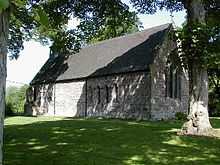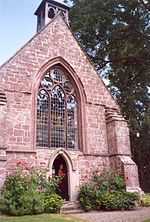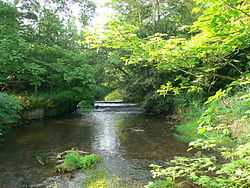Longnor, Shropshire
| Longnor | |
 Longnor |
|
| Population | 231 [1] |
|---|---|
| OS grid reference | SJ485005 |
| Civil parish | Longnor |
| Unitary authority | Shropshire |
| Ceremonial county | Shropshire |
| Region | West Midlands |
| Country | England |
| Sovereign state | United Kingdom |
| Post town | SHREWSBURY |
| Postcode district | SY5 |
| Dialling code | 01743 |
| Police | West Mercia |
| Fire | Shropshire |
| Ambulance | West Midlands |
| EU Parliament | West Midlands |
| UK Parliament | Shrewsbury and Atcham |
|
|
Coordinates: 52°36′N 2°46′W / 52.6°N 2.76°W
Longnor is a village and civil parish located just off the A49 road south of Dorrington and north of Leebotwood in Shropshire, England. With a population of 231, Longnor is a relatively small village, the nearest train station is 4.7 miles away in the town nearest to the village of Church Stretton.
The Cound Brook, a tributary of the River Severn flowing from the All Stretton area and entering the Severn near Cound, flows just to the west of the village and the medieval deer park. The village is notable for its medieval deer park, as well as the famous Shropshire ghost, the White Lady of Longnor. The village is also home to Longnor Hall and St. Mary's Church a grade 1 listed medieval church. Regional Cycle Route 32/33 passes through Longnor, on its way from Little Ryton to All Stretton. As do a couple of bus routes on their way from Church Stretton to Shrewsbury and Radbrook Green. There is a primary school, Longnor CE Primary School, in the village.[2]
Facilities
Education
Longnor CE Primary School is the village primary school, in January 2011 it had 112 pupils enrolled aged between five and eleven.[3] There is also a pre-school in Longnor called Little Seekers.[4]
Church


St. Mary's church is a Grade 1 Listed Building it is an ancient building in medieval (early English) style, it has been continuously carefully conserved over the years. For the turn of the millennium in the year 2000 it had two new stained glass windows fitted.
Originally a chapel to Condover it was then turned into a chapel for the Corbett family of Longnor Hall before eventually evolving into the parish church.[5]
Food and Drink
The nearest restaurant is 1.7 miles away in Leebotwood South East of Longnor. The restaurant is called The Pound and serves British cuisine.[6] The nearest pub to Longnor is the Fox Inn which is 1.7 miles away, in Little Ryton.
Local Government
Leebotwood & Longnor Parish Council
Longnor is part of a joint parish council with another local village, Leebotwood. As of 2008 the electorate in the parish was at 343 members, who vote on matters of importance to the parishes, such as ways of improving the quality of life of the two communities and also looking after the environment. It has the power to influence and work alongside other bodies such as the principal authority Shropshire Council, Police, Highways Agency, PCT and others to ensure that their services are doing the best for the area.[7]
Longnor Hall
- Not to be confused with Longner Hall, near Shrewsbury
Longnor Hall features a park and formal gardens, the park originated in the 14th Century. In the 17th century it was turned from being a park to having formal gardens laid out. It is now left with having the 18th Century park and modern gardens still in survival.[8] The current hall was built by Sir Richard Corbett in 1670 as successor for Roger Sprencheaux's fortified manor house from 1235.[9] The hall had some alterations done between 1838 and 1842 by the architect and builder Edward Haycock Snr.[10][11]

Corbet Family
The Corbett Family were the builders and original inhabitants of Longnor Hall. Originally built for Sir Richard Corbett in 1670 and finished in 1693 for his son, Uvedale Corbett, in 1694.[10] The name of Corbet arrived in Shropshire in the times of the Norman Conquest, when Hugh Corbet settled in the area. The name developed from Corbet, to Corbett, and the branch of the Corbett family living in Longnor dates from the 1500s. The last in this line was Jane Corbett who married archdeacon Joseph Plymley, however he took on the name Corbett and it has continued on. However many Corbets or Corbetts by the 19th Century had moved away from Shropshire.[12]
Farming
Longnor is home to numerous different farms, five of which are, Micklewood Farm, Shrubbery Farm, Upper House Farm, The Farm and Green Farm.[13] These farms are the main economic force in the area, the majority of industry in the area has been in agriculture throughout history.[14] One farm is specialised in the milk industry, Green Farm, which in 2010 acquired a modern milking facility to boost production and profits.[15] The farm however is not just focused on dairy farming; it also produces mixed crops.[16]

Natural Features
Cound Brook
Cound Brook is a 25-mile long tributary of the River Severn, it runs from the All Stretton area, through Longnor, Condover and exits into the Severn near Cound. Longnor is situated in the middle section of Cound Brook. Having rainwater runoff from the Stretton Hills join it, the brook rapidly widens to a significant flow, passing to the east of Leebotwood and west of Longnor and the Medieval deer park there. Continuing to the east of Dorrington village, at Stapleton the Cound changes direction and heads eastwards. The flow of the Cound Brook can vary from a slow, sluggish flow in a dry summer to a raging torrent in winter or spring.[17]

Medieval Deer Park
A medieval deer park was an enclosed area containing deer. It was bounded by a ditch and bank with a wooden park pale on top of the bank. The ditch was typically on the inside,[18] thus allowing deer to enter the park but preventing them from leaving. There is a medieval deer park in Longnor.
Climate and Environment
The climate in the area of Longnor is typical for England and especially the area, being of a temperate nature. This means that there is relatively little variation in the climate between summer and winter. Longnor is in the part of England however that can get hit by some extremes of weather for example snow in winter months, for example snow warnings were issued for Shropshire in April 2012.[19] As it lies in the midlands of Britain, it has a climate that is essentially transitional between northern and southern England in terms of temperature differentials and also between Wales and eastern England with regards to levels of rainfall.[20]

History
In 1870–72, John Marius Wilson's Imperial Gazetteer of England and Wales described Longnor like this:
Longnor, a village and a parish in Church-Stretton district, Salop. The village stands on the river Onny, near Watling-street, 1½ mile NNE of Leebotwood r. station, and 5 NNE of Church-Stretton; and is supposed to occupy the site of a Roman station. The parish comprises 1,200 acres; and its Post town is Leebotwood, under Shrewsbury. Real property, £3,656; of which £88 are in mines. Pop., 244. Houses, 48. The property is divided among a few. Longnor Hall is a chief residence. Coal is found, but is worked less now than formerly. The living is a vicarage annexed to the vicarage of Leebotwood, in the diocese of Lichfield. The church is ancient but good; and belonged formerly to Haughmond abbey. There are a national school, and charities £44. The Rev. Samuel Lee, late professor of Arabic at Cambridge, was a native. [21]
Shropshire Ghost
- The White Lady of Longnor
The White Lady of Longnor is one of Shropshire's most famous ghosts. She appears clothed in her long white wedding dress. Her haunt is on or near the road bridge near the village, she is thought to have thrown herself from the old bridge into the water below after being deserted at the altar. She is rumoured to stand staring at the water as it flows beneath her feet. There are various accounts of what she appears to do, one is that she will drift eerily through the parapet of the bridge and fall slowly into the stream then fade away. Another claims that she attends village dances and parties.[22]
Transport Links
Road
| |
|---|---|
| Route information | |
| Length: | 140 mi (230 km) |
| Road network | |

The A49, is the main road that passes by Longnor just to the West of the village. It heads from South to North traversing the Welsh Marches region from Hereford to Wigan. The road provides the main routes from Longnor into the surrounding towns and villages, especially into Shrewsbury and Church Stretton, with Church Stretton being where the nearest shops are to Longnor as it is the nearest town. The A49 is also the road which has the bus links for the people of Longnor, having the number 435 bus stopping just to the North of the village on the road.[23]
Cycling
Regional Route 32/33
Regional routes are an integral part of the National Cycle Network, serving to link most Route 32; Route 33; Route 41; Route 42; Route 43; Route 44; Route 45; Route 46; Route 47. Regional Cycle Route 32/33 passes through Longnor on its way from Little Ryton to All Stretton as part of National Cycle Route 44.[24]
Train
The nearest train station to Longnor is 4.7miles away from the village in Church Stretton. The station can be accessed via the number 435 Bus the route of which goes from Church Stretton through Longnor and other locations en route to Shrewsbury. The next nearest train station is in Shrewsbury 7.7miles to the North of the village.[25]
Bus
Bus routes that go through Longnor are the number 435 and 540. Both start in Church Stretton being the largest town near to Longnor, the 435 goes through a number of different villages, including Longnor on its way to Shrewsbury. The 540 has different destination at the end of its route being Radbrook Green a suburb of Shrewsbury.[25]
External links
| Wikimedia Commons has media related to Longnor, Shropshire. |
| ||||||||||||||||||||||
- ↑ http://www.neighbourhood.statistics.gov.uk/dissemination/LeadAreaSearch.do?a=3&r=1&i=1001&m=0&s=1332245136778&enc=1&areaSearchText=SY5+7PP&areaSearchType=16&extendedList=true&searchAreas=
- ↑ OFSTED
- ↑ http://www.shropshire.gov.uk/schools.nsf/open/8DE172506F95493780256E910041791A
- ↑ http://www.cylex-uk.co.uk/company/little-seekers-17895919.html
- ↑ http://www.achurchnearyou.com/longnor-st-mary/
- ↑ http://www.tripadvisor.co.uk/Restaurant_Review-g315989-d1379298-Reviews-The_Pound_at_Leebotwood-Church_Stretton_Shropshire_England.html
- ↑ http://www.2shrop.net/LeebotwoodandLongnor
- ↑ http://www.parksandgardens.ac.uk/component/option,com_parksandgardens/task,site/id,6300/Itemid,292/
- ↑ http://www.melocki.org.uk/salop/Longnor.html
- ↑ 10.0 10.1 http://www.britishlistedbuildings.co.uk/en-259606-longnor-hall-longnor
- ↑ http://www.tkellner.com/index.php?id=3344
- ↑ http://www.selectsurnames.com/corbett.html
- ↑ http://www.streetmap.co.uk/map.srf?x=349673&y=299863&z=106&sv=349673,299863&st=4&ar=Y&mapp=map.srf&searchp=s.srf&dn=747&ax=349500&ay=300500&lm=0
- ↑ http://www.visionofbritain.org.uk/data_theme_page.jsp?u_id=10362702&c_id=10001043&data_theme=T_IND
- ↑ http://www.fullwood.com/customers/content/76
- ↑ http://www.brownbook.net/business/1087195/j-m-p-thomas
- ↑
- ↑ Rackham, Oliver (1976). Trees and Woodland in the British Landscape. Archaeology in the Field Series. London: J.M. Dent & Sons Ltd. p. 150. ISBN 0 460 04183 5.
- ↑ http://www.shropshirestar.com/news/2012/04/11/weather-more-snow-on-the-way-to-shropshire/
- ↑ http://www.metoffice.gov.uk/climate/uk/mi/print.html
- ↑ Southall, H. "Longnor History". Vision of Britain.
- ↑ http://www.shropshirestar.com/news/2011/10/31/shropshire-%E2%80%93-a-haunted-haven/
- ↑ http://shropshire.gov.uk/bustimes/stop.jsc?stop=3500B143701
- ↑ http://www.servinghistory.com/topics/National_Cycle_Route_44::sub::Regional_Route_32_33
- ↑ 25.0 25.1 National Rail. "Longnor Buses".
